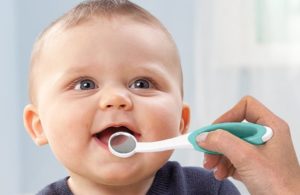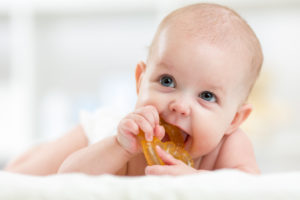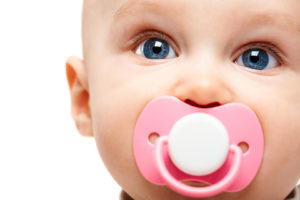While most babies don’t start getting teeth until they are six months old, infant dental care is important from the very beginning. Many dentists recommend an initial visit before the child’s first birthday to make sure teeth and gums are cared for and cleaned properly. 
It is a good idea to get in the habit of cleaning your baby’s gums soon after birth. Although there may be a little fussing at first, your infant will get used to having the mouth cleaned like other parts of the body. Many children grow to enjoy tooth brushing as part of their daily routine.
During your baby’s first year, there are a few conditions to be aware of, including:
Teething
Between 3 and 9 months, your infant’s baby teeth will begin to emerge (erupt) into the mouth. Teething may make your child irritable or fussy and may cause restlessness, drooling or loss of appetite. However, it has not been shown to cause any other childhood symptoms.
Baby Bottle Tooth Decay
Baby bottle tooth decay — also called “early childhood dental caries” — is one of the most important issues in infant tooth care. This condition is caused by frequent exposure, over time, to sugary liquids, which can seriously damage a baby’s teeth and overall oral health.
Pacifiers
Sucking is a normal part of development that is comforting to children well into their first years of life. In fact, sucking often brings comfort even after a child no longer needs to get nourishment from a breast or bottle. During a child’s first few years, sucking habits probably won’t damage his or her mouth. But frequent and long-term sucking can cause problems. This is especially true if the habit continues after baby teeth start to fall out.
Planning
Teething
Some babies may have sore or tender gums when teeth begin to erupt. Gently rubbing the gums with a clean finger, an infant gum massage or a wet gauze pad can be soothing. A clean teething ring for your child to chew on may also help. 
You can ease your child’s teething discomfort by:
- Rubbing your baby’s gums to apply pressure
- Giving your baby a cold teething ring to chew on
First Teeth
Caring for your baby’s first teeth is very important, and helps set the stage for a healthy mouth.
Tips to clean your baby’s mouth:
- Lay your infant in your lap. The head should be close to your chest so you can look down directly into your child’s mouth.
- Clean the gums and the teeth — when they arrive — by rubbing a clean, damp, wash cloth along the baby’s upper and lower gums. You can also use terry cloth finger cots, which fit over the finger and are made for this purpose.
- Follow these steps at least twice a day — once after breakfast, and once after the last feeding of the day.
- When the teeth begin to erupt, start brushing them at least two to three times a day with a soft-bristled toothbrush and water. Toothpaste is not recommended until a child reaches age two. At that time, supervise brushing to ensure that your child does not swallow any toothpaste.
Tooth Decay
This harmful process occurs when acid formed by bacteria on the teeth, from sugars in foods and beverages, damages the tooth enamel, which causes demineralization, and eventually can lead to a cavity. To avoid tooth decay, never let a child fall asleep with a bottle in his or her mouth or to nurse continuously as he snoozes. If your baby needs something to suck on to fall asleep, offer a bottle filled with water or a pacifier.
Pacifiers
If your child uses a pacifier, make sure it is always used safely: Never fasten a pacifier on a string or necklace around your child’s neck, or else your child could accidentally be strangled.
Choose a pacifier that:
 Is one piece rather than several parts
Is one piece rather than several parts- Has ventilating holes on the sides.
- Is large enough so that your child can’t swallow it.
- Is made of a flexible, non toxic material.
- Has a handle that is easy to grasp.
- Always check the pacifier before giving it to your child. Make sure there are no rips or tears. If there are, replace it. Never dip a pacifier in honey or any other sweet substance before giving it to your baby.
CHILDREN’S ORAL CARE
Take good care of your child’s baby teeth. They do eventually fall out but until they do, baby teeth play an important role in helping your child bite and chew food, and speak clearly. Baby teeth also save space for the permanent teeth, and help guide them into place.
Even before your child gets his or her first tooth, you should wipe your child’s gums with an infant gum massager, clean damp gauze or a washcloth. Once your child’s teeth come in, brush them twice a day using a soft bristled toothbrush with water.
Underneath your child’s baby teeth, the roots and position of the adult teeth are growing into place.
Research shows that children who develop cavities in their baby teeth are more likely to develop cavities as an adult, so be sure to get your child to a dentist for a checkup. It is important to keep your child’s baby teeth clean, but once the permanent teeth start to come in you really need to make cleaning them a priority.
These teeth will last your child a lifetime.
Of course, even though they’re kids, their teeth are still susceptible to the same conditions and damage that adult teeth face. If your child is at high risk for cavities, it’s time to cut down on the starchy snacks, such as crackers and chips, and limit sugary beverages. Remember that giving your child a bottle of sweetened liquid many times a day, or allowing your child to fall asleep with a bottle during naps, or at night, can be harmful to the child’s teeth.
Many of the same treatment and evaluation options that adults have are also available to kids. These include x-rays, dental sealants, orthodontic treatment and more.
Losing Baby Teeth
On average children begin to lose their baby teeth when they are about 6 or 7 years old. It doesn’t mean something is wrong with you child if they lose their teeth before or after this time. Most children lose their teeth in the same order they came in. For example, they lose their bottom center teeth first.
Early Orthodontics
Children today tend to get braces at a much earlier age than in years past. Some patients with special problems begin orthodontic treatment as early as 6 years old. Permanent teeth begin to come in around this time, and it is when orthodontic problems become apparent. Because the jaw is still growing it’s an ideal time to evaluate a child.
Planning
Permanent teeth need regular cleaning and flossing, and dentists recommend following this routine after every meal. When you start to take care of your child’s permanent teeth, you will need to brush and floss his teeth for him until he gets a little older. Use toothpaste and a toothbrush designed for children.
A child’s toothbrush has softer bristles that will not hurt your child’s teeth and gums. Try using children’s flosses with handles so that you can teach your child how to floss his own teeth.
When a child is about 6 years old their teeth will begin to come loose. Let your child wiggle the tooth until it falls out on its own. This will minimize the pain and bleeding associate with a lost tooth.
Another thing to be on the lookout for is cavities. What and how frequently your kids snack can have a big impact on their oral health. Here are a few tips for snacking and mealtime:
Give your child healthy snack foods, such as fresh fruits, vegetables and cheeses.
Buy foods that are sugar-free or unsweetened.
Serve sugary or starchy foods as part of a meal, rather than as a snack. Most children drink liquids during a meal. This will wash many bits of food off the teeth. Encourage kids to drink water during and at the end of their meals to wash out any remnant sugar.
Offer fewer snacks during the day.
After your child snacks, make sure his or her teeth are brushed. If this isn’t possible, have your child rinse with water several times.
When chewing gum, choose a xylitol-sweetened or sugar-free gum.
The Best Foods for Your Child’s Teeth
In addition to regular brushing with fluoride toothpaste, the food and drinks your child consumes have an important role in maintaining a healthy mouth. Outside of the commonly known advice to avoid sugary foods and drinks, the foods that are safe for teeth are less well known. Below is an outline of some of the best foods for your child’s teeth as well as some foods you should only have as a treat and once or twice a week maximum.
Why Your Child’s Diet Matters?
A diet that offers a range of nutrients not only helps the teeth and gums grow properly, but it also decreases the risk of tooth decay. Establishing healthy habits early on will help to protect first the baby teeth and then the adult ones as they erupt.
What Foods and Drinks Are Best?
Many baby foods and drinks are surprisingly high in sugar. In fact, almost all foods contain some sugars. Between meals, teeth need time to recover. Try to keep sugary foods and drinks to mealtimes only and not before bedtime. As a rule, note that the only truly safe drinks for baby teeth are milk and water. For healthy teeth, give foods that that provide protein, vitamins A, C, and D, folic acid, calcium, and minerals. These nutrients help strengthen enamel and ensure gum health. The foods listed above are just some of the options that are safer for teeth. A balanced diet will provide your child with many of the vitamins and minerals the body needs to support a healthy mouth. If you’ve got any questions, talking to your child’s dentist or doctor may help.
Special Considerations for Babies and Toddlers
There are many things to keep in mind depending on your child’s age.
Babies (0-2)
- For drinks, give only milk and water.
- Introduce your baby to a free-flow cup from six months on, and stop bottle feeding completely by 12 months.
- Try and restrict a sugary food to a meal time only and do not give sugary foods and drinks before bedtime. If you need to give your baby a bottle at night, only give them water. If they are currently on milk, over a few weeks you can dilute this with water so that by the end they are only drinking water.
- Check baby food ingredient labels to ensure no sugar has been added. Added sugar comes in many forms including honey, molasses, corn sugar, maple syrup, agave syrup, dextrose, fructose, glucose, sucrose high-fructose glucose syrup, and more.
- Safe snacks between meals should not contain sugar. Try fresh fruit, vegetables, bread sticks, cheese, and plain yogurt.
- Avoid fizzy drinks, soft drinks, juice, and squashes sweetened with sugar as much as possible. In fact, none of those has any health value in a child’s daily diet. Sweet drinks can lead to tooth decay, and babies who taste sugary drinks often struggle to move to safer options. Milk and water are best.
- Don’t worry if “bad food” moments occasionally happen. If you can, restrict giving sweet foods to mealtimes as this will reduce the damage to their teeth.
- Do not give sugary foods and drinks before bedtime and be sure to wipe your baby’s gums or brush their teeth before bed. If you give your baby a bottle at night, only give them water.
- Further advice is available from your health visitor, dental team, or other healthcare professionals.
Toddlers (3-5)
- Set a food schedule with your toddler. Aim to have three meals and two safe snacks a day. These two safe snacks between meals should be low in added sugar. Try fresh fruit, vegetables, bread-sticks, cheese, and plain yogurt. For drinks, stick with milk and water.
- Try to avoid fizzy drinks, soft drinks, juice, and squashes sweetened with sugar as much as possible. In fact, none of those has any health value in a child’s daily diet. Sweet drinks can lead to tooth decay, and toddlers may resist safer options if they’ve developed a taste for sugary drinks. Milk and water are best for toddlers.
- Don’t worry if “bad food” moments occasionally happen. If you can, restrict giving sweet foods to mealtimes as this will reduce the damage to their teeth.
- Do not give sugary foods and drinks before bedtime, and be sure to brush your toddler’s teeth with fluoride toothpaste before bed.
Thumb Sucking – Effects on Teeth, Prevention & Remedies
It’s not uncommon for a child to suck his or her thumb, lip or a finger, as a way to self-soothe or to help fall asleep.
When Do Children Stop Thumb Sucking?
Most children outgrow thumb sucking between ages 2 and 4 years, which is the time when the first baby teeth fall out and permanent teeth appear. But it’s important to break a child of a thumb-sucking habit before the permanent teeth start to arrive in order to prevent problems with tooth alignment and development of the mouth.
Is Thumb Sucking Bad?
How intensely your child sucks his or her thumb can make a difference in the risk of problems with dental health later on. A child who sucks their thumb or finger aggressively is at greater risk for damaging teeth than a child who keeps a thumb or finger passively in their mouth.
How to Stop Thumb Sucking?
Any type of thumb, finger or lip sucking is a habit that should be broken. It’s not always easy, but it can be done. Try these tips:
Catch them being good. Notice when the child is not sucking a thumb and praise him or her effusively, rather than scolding when the child is sucking the thumb.
Provide calmness and comfort. Many children suck a finger or thumb when they feel anxious. Try to determine any specific causes of anxiety for your child that might prompt thumb sucking, and address them.
Enlist their help. Ask older children to help develop methods to break the habit. For example, older children may only suck a finger or thumb at night. Try putting a sock over the hand or taping two fingers together with athletic tape.
Enlist the dentist. Ask your child’s dentist to support and encourage the child to break a thumb or finger-sucking habit.
Make brushing your child’s teeth fun!
What’s the Proper Way to Brush My Toddler’s Teeth?
It’s a good idea to supervise your child’s brushing until the age of six, following the guidelines below:
- Use a pea-sized amount of a fluoride toothpaste. Take care that your child doesn’t swallow the paste.
- Use a toothbrush with soft bristles, brush inside surfaces of all teeth first, where plaque accumulates most. Angle bristles toward the gum line. Brush gently back and forth.
- Clean all outside surfaces of teeth. Angle bristles toward the gum line. Brush gently back and forth.
- Place brush so bristles are on the chewing surface of the teeth. Brush gently back and forth.
Think of creative ways to make brushing your teeth fun. For example, listening to fun sounds or songs while brushing can help make the entire experience a pleasant, and even fun one. Try listening to a song that is two minutes long to help keep yourself and your kids brushing for the full duration of time recommended. Also, having a cool toothbrush designed for kids that features their favorite characters helps brings out the fun in brushing and allows children to bring their favorite cartoon and television friends into the bathroom with them.
Develop a Reward System – Children should brush their teeth twice a day and floss daily, so try keeping track of your child’s brushing on a calendar by the sink with gold stars. If there are two stars at the end of the week, play their favorite game on Friday night as a special prize.
Make Brushing Time Family Time – At night, get together in the bathroom to brush our teeth for the recommended two minutes. Play your favorite song (which is usually around two minutes) and brush together for the duration of the song.
Get Kids in the Right Frame of Mind for the Dentist – Dentists recommend dental check-ups every six months, which can be scary for many children. So prepare them beforehand. Give them an idea of what to expect; try using picture books or do some role-playing exercises to explain to kids what to expect during a dental visit. After the visit, reward them for good behavior with their favorite television show or a fun activity.
Bring Variety to Brushing – Let your children choose different kinds of fluoride toothpaste, toothbrushes and floss to keep in the bathroom so that they can have options each time they brush.
Choosing the Best Toothpaste for Children
To maintain excellent oral health in your child, it is important to select an appropriate sized toothbrush and a nourishing, cleansing brand of toothpaste. With so many products on the market, this decision can be an overwhelming task.
How to Choose a Toothpaste?
The age of the child is important when choosing toothpaste. Before the emergence of the first tooth, oral care needs to be started. To remove bacteria and food particles, gently rub a clean wet cloth inside the mouth along the upper and lower gum lines. Oral care in babies should be done after each feeding.
For children ages 1-2 years of age the primary teeth begin to erupt and a brushing routine needs to be established. Primary teeth are important for chewing, speech production and proper jaw development.
They also play a role in proper spacing and alignment of the permanent teeth. Proper oral care and brushing of the primary teeth helps prevent tooth decay, gum disease and bad breath. At this age, it is important to choose fluoride-free toothpaste and use a soft toothbrush. You may have to experiment to select a flavor that your child likes.
Children 2-5 years of age can begin using fluoride toothpaste. In selecting toothpaste choose a flavor that your child likes. Apply a pea size amount to a soft toothbrush and encourage your child to spit out the excess toothpaste. If a small amount of toothpaste is ingested, do not worry.

